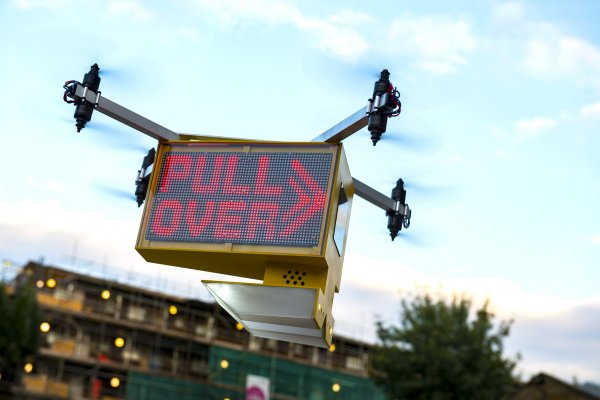The Drone Aviary

In its activities, the collective "Superflux" combines design and technology with an artistic practice that focuses on strategies of living together. In installations and videos, the designers and researchers of "Superflux" critically examine possible models of the future and attempt to depict these models through computer-generated images.
The project Drone Aviary was developed in 2015 and has since been continued with installations and publications. A video and three objects are presented at esc medien kunst labor. In the video, various drones, including Nightwatchman and RouteHawk, become protagonists, the world is presented from the perspective of the drones. They collect data and perform their tasks. "A speculative map shows where physical and digital infrastructures merge." This addresses a reality in which digital structures have gained physical autonomy and make independent decisions. Featured in the exhibition as objects are the actors Newsbreaker (the media drone), Nightwatchman (a surveillance drone) and Madison (an advertising drone).
With the Drone Aviary project, the social, cultural and political potential of drone technology is put up for discussion. In the appropriation of public space by the autonomously acting drone, a critique also becomes tangible - for example, in thoughts of war drones. How will urban space change through the use of drones? Or rather, how has it already changed? As "Superflux" stated in a journal: "And that is precisely the goal of the Drone Aviary project: to explore the physical, digital, spatial and social complexities of this technology. In our work, we use the term 'drones' to suggest partial or full autonomy, though we are more motivated to use this technology as a vehicle to think about the broader implications of integrating personal robotics into our daily lives."
The video's narrative, which actually seems ominous, a world told from the bird's eye view of a smart technology, puts the drone's utility, purpose and applications up for discussion. Another project in the exhibition, Roland Jankowski's Duality, similarly references these contexts. From the arts, these two projects in the exhibition negotiate a currently very topical socio-political issue - namely in relation to the question of how we deal with technology. In the process, the darker sides of artificial intelligence become just as much the content of the artistic debate as its potential. [MA Elisabeth Passath]
